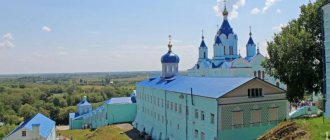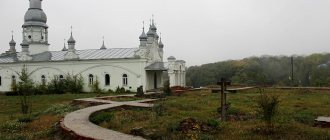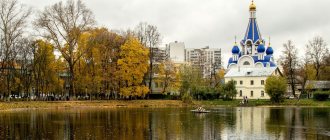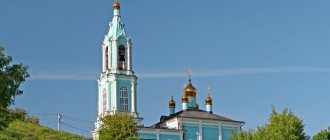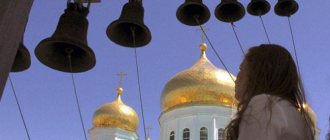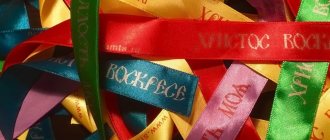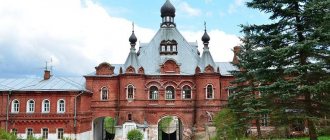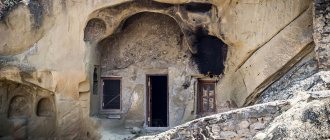Equal to Optina Pustyn
Glinskaya in honor of the Nativity of St.
Our Lady of the Deserts. 19th century lithograph Photo: pecherskiy.nne.ru In recent centuries, this monastery in popularity among believers was second only to the Kiev Pechersk and Pochaev Lavras. And its glory lay not in its antiquity, not in the sophistication of its architectural buildings, but in the people who stayed within its walls and prayed there.
A unique institution of eldership was formed in the Glinsk Hermitage, and in the 19th century a period of prosperity began here. For almost two centuries, the Glinskaya and Optina hermitages were the most famous in Rus', and a spiritual connection can be traced between these two monasteries and its devotees. The elders of both monasteries had spiritual and prayerful communication with each other, common spiritual children, visited each other, and carried on correspondence, which has partially survived to this day.
The experience of the Glinsk Hermitage influenced dozens of large monasteries of the Russian Empire, some adopted the charter and experience of spiritual life.
According to church historians, the eldership in Rus', revived by the Monk Paisius (Velichkovsky), was divided into several main movements: northern, central and southern. Glinskaya Hermitage belonged to the last of them. The high feats and spiritual talents of the Glinsk monks made the monastery widely known and the hermitage was also called the adornment of monasticism.
Many elders sent those wishing to become monks to the Glinsk Hermitage, including the Monk Seraphim of Sarov. The experience of the Glinsk Hermitage influenced dozens of large monasteries of the Russian Empire, some adopted the charter and experience of spiritual life. For example, the charter of the Glinsk hermitage also passed to the Svyatogorsk Assumption Hermitage (now the Lavra), a significant part of the monastics in which consisted of Glinsky monks.
Patronal holidays[edit]
Nativity of the Blessed Virgin Mary
- September 21
Icon of the Most Holy Theotokos “Iverskaya”
— October 26, February 25, May 6
Nicholas the Wonderworker, Archbishop of Myra, Saint
— May 22, December 19
Memory of St. Glinskikh - September 9 (22)
Hegumen Filaret (Danilevsky). The birth of traditions
Hegumen Filaret (Danilevsky).
Photo: floxasia.ru The Glinsk hermitage appeared in the 16th century in the Kursk province (now Sumy region, 15 km from the city of Glukhov) at the site of the appearance of the miraculous icon of the Nativity of the Virgin. The name “Glinskaya Hermitage” does not come from the word “clay”, as some people think. And the soil in those places is more sandy.
The name of the desert comes from the name of the ancient princely family, from which Elena Glinskaya, the mother of Ivan the Terrible, came. The ancestor of this family was the Tatar Murza, who converted to Christianity and later entered the service of the Lithuanian prince. As a reward, he received the small town of Glinsk (he named it the Glinyak stream) and this place was called Glinskoe Uzhozhye. After the miraculous appearance of the icon, the first hermit-dwellers appeared here, and although at first the Glinsk Hermitage belonged to different monasteries, later it became independent.
Priests who violated church discipline and were under penance were sent here for correction.
The monastery did not stand out as anything special until Abbot Philaret (Danilevsky) appeared here in 1817. He came from the neighboring Sofronievskaya hermitage, where for 15 years he labored and became familiar with the true elder tradition. At that moment, the monastery consisted of 25 brethren and several dilapidated buildings; it was officially considered supernumerary, i.e. on their own and without government support. Priests who violated church discipline and were under penance were sent here for correction.
Despite the depressing state of affairs, Abbot Philaret decides to implement the ideas and teachings of St. Paisius (Velichkovsky) and takes up discipline and construction. He becomes not just a renovator, but rather even the spiritual founder of the monastery, which will subsequently be known throughout Rus' thanks to his eldership and widespread charity.
According to archival materials, by the end of the 19th century, about 400 monks labored in the Glinsk Hermitage, there were 5 temples and several house churches, there were more than a dozen buildings for the monks of the monastery, a hotel for pilgrims, a refectory, a hospital, numerous outbuildings, four water mills and a large stone fence around the entire monastery.
Thanks to the care of Abbot Philaret, boys, mostly orphans, were taught at the monastery; there was a house of mercy for the poor. The monastery carried out educational activities through the famous “Glinsky leaflets”, spiritual literature was published, and the monastery had a very large library.
“This is how the souls of the righteous depart! Now Father Seraphim has rested in Sarov."
The rector is also known for having formed the unusual tradition of Glinsky liturgical singing, writing many works with his own hand, and publishing collections of music. Partes singing in the monastery was prohibited.
Hegumen of the monastery Philaret possessed the gift of clairvoyance and was honored to see the soul of the deceased Venerable Seraphim of Sarov ascended by angels with glory to heaven. One day the elder pointed to an extraordinary light in the night and said: “This is how the souls of the righteous depart! Now Father Seraphim has rested in Sarov.” The abbot of the Glinsk Hermitage was known both to ordinary believers and to royalty. He was personally acquainted with Emperor Alexander I, Nicholas I, and Empress Elizaveta Alekseevna. They all respected the elder and asked for his blessings and advice.
It is known for certain about the 16 elders of the Glinsk Hermitage. All of them were recently glorified as saints and the relics of many of them rest in one of the monastery churches.
Location[edit]
Address:
41442, Ukraine, Sumy region, Glukhovsky district, village. Sosnovka
Telephone:
(05444) 6–74–37
Directions:
The monastery has at its disposal an intercity bus “Bogdan” (Isuzu), designed for 27 passengers, which can serve organized groups of pilgrims. For example, it is possible to meet groups of pilgrims at the Konotop, Krolevets, Voronezhskaya, Shostka or Putivl railway stations, as well as deliver them to neighboring monasteries in the Sumy and Chernigov regions.
On water as on dry land
Glinskaya desert.
Photo. Beginning XX century Photo: monasterium.ru In order to have an idea of the spirituality of the elders, it is necessary to mention the rector of the Glinsk Hermitage, Schema-Archimandrite Ioanniki (Gomolko). During his lifetime, the elder was distinguished by concentration, self-absorption, and preservation of the mind, which is where true asceticism lies.
In the pre-revolutionary years, censorship was weakened, and materials of dubious content began to appear in the press. In one of the local newspapers, Elder Ioannikios was slandered by a local landowner, who also had litigation with the monastery. The ruling bishop at that time, Archbishop Stefan of Kursk, was distinguished by a very difficult character, and without knowing Ioannikis personally, he made a hasty and unfair decision on this issue.
Without understanding the situation, the bishop ordered the governor to leave the monastery within 24 hours. But Abbot Ioannikiy was innocent and showed his innocence to everyone in a miraculous way.
Father Ioannikis blessed the water with the sign of the cross and walked on it, as if on dry ground, before everyone’s eyes and left the monastery.
During the time of Father Ioanichios, the swamps around the monastery had not yet been drained and the Obesta River overflowed very extensively. The events described took place just during the spring flood of the river. Obeying the order of the archbishop, the elder left the monastery - and there was water all around. But what he saw did not confuse the obedient abbot: Father Ioannikis blessed the water with the sign of the cross and walked over it, like dry ground, before everyone’s eyes and left the monastery.
He was a true ascetic of his time, an elder, a holy man. Before the canonization of the saint in the 21st century, they managed to find a grandmother, whose ancestors sheltered the exiled priest Glinsky. Her relatives said that a monk came to them by water. Through his prayers, the entire family of those who sheltered him had a blessing from God, everyone was healthy, had strong families, no one was dispossessed or died in the war, and during the famine there was always food.
It is interesting that the patron saint of Ioannikis of Glinsk, the 8th century saint Ioannikis the Great, also performed a similar miracle in his life when he walked on water without getting his feet wet when the river flooded.
“Everything in Glinskaya breathes holiness”
At the beginning of the twentieth century, the Glinsk Hermitage was a provincial monastery located in the wilderness, but its fame extended not only throughout the entire Russian Empire, but also far beyond its borders. The main feature of the monks was their internal spiritual activity, which was later called the “phenomenon of old age.” After the revolution, the monastery was closed and all its churches were destroyed. Now the area resembles a large construction site. Even the pilgrimage hotel is temporarily housed in construction trailers. However, despite the external disarray, a special, unique spirit is still felt here, which attracts admirers of the Glinsky ascetics here (the monastery contains the relics of ten famous elders).
We talk about how the revival of the monastery is happening with Archpriest Alexander Churochkin, a candidate of theology, local historian and archivist of the Glinsk Hermitage.
Glinskaya Pustyn
God's construction
– Father Alexander, how long have you been studying the history of this monastery?
– I myself am a native of the city of Putivl. My ancestors are from here. My field of interest also includes the Sophronie Hermitage and the Molchensky Monastery - all the shrines of this region. Before entering the Theological Academy, I graduated from the history department of Sumy Pedagogical University. The topic of my candidate's dissertation is “Putivl land: an ecclesiastical and archaeological essay.” I’m 36, and probably since I was 15, that is, half my life, I’ve been doing this.
For several years I was a full-time priest of the Glinsk Hermitage. Then there was no fence, nothing - just a group of buildings in the middle of the forest. Now, of course, the monastery is already taking on some features. So far, life here is just getting better, and Bishop Anthony[1] and his brethren are trying to revive the Athos charter, as it was before the revolution. They are gradually developing the territory, setting up a household in order to somehow support themselves, because construction requires a lot of money.
The Glinsk Hermitage had land holdings and farms. For example, I saw in documents a record that a house church was built at the Negrovsky farm. And what kind of farm this is – we still can’t find it anywhere. The farmstead was in Glukhov, in Putivl - with mills, with a temple. The monastery was very rich.
There is no clay here, there is sand here. And the name comes from the name of the ancient princely family of Glinsky
The soil here is sandy, so the name “Glinskaya Hermitage” does not come from the fact that potters mined clay here, as is written in some books. There is no clay here, there is sand here. And the name comes from the name of one ancient princely family, from which Elena Glinskaya, the mother of Ivan the Terrible, came. Their ancestor is the Tatar Murza. He converted to Christianity and became Alexander in baptism. He entered the service of the Lithuanian prince and received the town of Glinsk as his inheritance. There was a stream called Glinyak (now a village in Romensky district, Sumy region). Hence their surname Glinsky. It's about 100 kilometers from here.
So these princes were the governors of Putivl, and here they had the Glinskoe beekeeping chamber, in which one of the beekeeping beekeepers found the icon of the Nativity of the Mother of God of the Desert-Glinskaya. They began to call it that - after the location of this tract.
– How was the Glinsk Hermitage revived? Was this a diocesan decision?
– When the desert was closed in 1922, these places still belonged to the Kursk province. It reopened in 1942 during the German occupation. Then it was already the Sumy diocese. In 1994, this place was on the territory of the newly formed Konotop diocese, which raised the issue of returning two monasteries to the Church - the Peter and Paul Monastery and the Glinsk Monastery. Both monasteries then housed boarding schools for mentally ill women. In response, they were asked to choose one of them. The diocesan council chose the Glinsk hermitage. All the wards were transferred to the Peter and Paul Monastery, and from 1994 to 1997 the Glinsk Hermitage was under the jurisdiction of the Konotop diocese, and then became stauropegial.
– How did the decision about stauropegia come about?
– In the village of Novaya Sloboda, where I now serve, there once lived a boy named Vanya Gudimov. In the summer of July 7, 1942, he was grazing cows in a meadow. And while he was not at home, the village was burned and his parents were killed. It was a terrible tragedy: in Novaya Sloboda, punitive Magyars massacred 586 civilians - old people, women, and children - in two hours. No one was spared. This Vanya was left an orphan. He had an aunt who was a nun. She brought him to the Glinsk Hermitage, where he was subsequently tonsured a monk with the name Leonty. Then he was sent to study at the Odessa Seminary. Later he graduated from the Moscow Theological Academy and became a metropolitan. At one time, he headed the Crimean, Kherson, Kharkov and even Berlin departments. Metropolitan Leonty was very friendly with Metropolitan (then Bishop of Chernigov) Vladimir, who later became the Primate of the Ukrainian Church. He would later write that “Vladyka Leonty was dear to my heart. We met and came together to the closed Glinsk hermitage, where the memory of the venerable Glinskys was alive.” This is how His Beatitude Metropolitan Vladimir formed his reverent attitude towards the Glinsk Hermitage and its elders. Therefore, given the important place of the monastery in history, it was given the status of stauropegy.
– How many monks are there in the monastery today?
– In total, 20 people labor as novices. The daily routine now is like on Mount Athos. At 8 pm Vespers is served, after which the brethren go to a meal, after which Compline is read in the church. Then the bell rings - this means that walking around the monastery is prohibited, talking is also prohibited, and a time of silence begins. The monks in their cells read the rule and prepare for bed. Then we get up at night. At about 4 am, Midnight, Matins, Hours and Divine Liturgy are served. After the Liturgy there is a meal, then the monks go to obedience. Then about two hours - rest, after which the evening service again. This rhythm is now observed in the monastery. Like on Athos. In particular, in the Vatopedi monastery the daily routine is exactly the same.
– Where do the monks come here from?
– Mainly from Ukraine. Five people are from Kharkov. From Krivoy Rog, Nikolaev. There are from Belarus. But you shouldn’t ask a monk who he was in a past life. A person comes here to change his life, to serve God. And the past life of a monk is a hidden thing
– What buildings remain here today from pre-revolutionary times?
– At the time of the closure of the Glinsk Hermitage in September 1922, it was a whole town. If you look at lithographs and views of the monastery, you can see that there were many buildings. But by the end of the 1920s, all the temples, except one (and there were four of them - three stone and one wooden) were destroyed. Now, of the pre-revolutionary buildings here, you can only see the refectory, next to it a red brick barn for household purposes, a fraternal building and a bishop's house. Fragments of the fence remained here and there.
When I first came here, I was struck by the appearance of the Holy Cross Church. It was made of wood, and adjacent to it was a long residential building with cells. Before the revolution, there were up to 700 monks here, including elderly ones. These people gave their entire lives, health and youth to the monastery, and the monastery took care of them until the end of their days. They were housed in a special hospital building, where they set up a house church. When the monks came here again in 1942, they revived the liturgical life here and decorated everything splendidly. But in 1961, the monastery was closed again and given over to the needs of a home for the disabled. At the same time, a toilet was immediately installed in the altar. And when I first saw this temple, it was numb, the wood was rotten, that is, it was turned into a ruin, into a ruin. If it had been made of stone, they would probably have tried to restore it. But the wooden collapsed structure had to be simply dismantled.
– Now the monastery is undergoing intensive construction. Is there any general plan of action?
– Since there is no serious funding for this construction now, it is difficult to plan it. After all, this is the outskirts, the province, and if many people used to come here, now there are very few pilgrimage groups. Our roads are also bad. Previously, those traveling from Russia to Kyiv traveled through the Katerynivka checkpoint and often stopped here. Now this is very difficult. And a secular person will not see any architectural ensemble here to, so to speak, “touch the antiquity.” Here the place itself breathes with antiquity, consecrated and prayed for by the monks. So it’s not tourists who come here, but mostly only pilgrims, those who want to pray, thirst for spiritual consolation.
Gate Church in the name of the Iveron Icon of the Mother of God
- Is the Revival proceeding according to old projects?
– No drawings or documents about the previous buildings have been preserved; only general photographic documentation was carried out. For example, the Iverskaya Church is now built as a gateway, although historically it was founded by St. Philaret[2] in a completely different place. St. Nicholas Church stood on the foundations of the destroyed Assumption Church.
At the time of destruction, the monastery was a group of buildings from different periods. They were built, fell into disrepair, and were rebuilt. Just like a person, when he lives, he doesn’t always wear the same clothes. If we take all significant monasteries, their history is a constant history of construction. But here, at the time of the revival, there was nothing to grab onto except the place itself. Therefore, construction here is carried out with an eye on the best traditions, as far as possible, of ancient Russian architecture and Orthodox canons. And instead of planning, they rely on the mercy of God: as the Lord manages, that’s how everything works out.
– From what sources is information about the history of the monastery collected?
– When the monastery was closed in 1922, a fire was lit here. They burned icons, books - everything was destroyed. There is a description of the Glinsk Hermitage archive - pre-revolutionary, but practically nothing from it has survived. In the surrounding villages, people still have books with stamps from the Glinsk Hermitage. So the archival searches are not yet completed.
The Glinskaya Hermitage was lucky to have Schema-Archimandrite John (Maslov) as its occupant: he wrote the fundamental work “Glinskaya Hermitage: the history of the monastery and its spiritual and educational activities in the 16th–20th centuries.” This is truly a colossal work, the appendix to it is the Glinsky Patericon in three volumes. But the archives of the Glinsk Hermitage are now scattered in other areas, because the current Sumy region is an artificial region: part of the Kursk, Chernigov, Kharkov and Poltava provinces. In this form it was formed in 1939. The Sumy archive contains service records of monks of the twentieth century. For the period of the second opening from 1942 to 1961, documents are also presented there. For example, correspondence from the Commissioner for the Affairs of the Russian Orthodox Church, which contains detailed reports on the condition of the monastery.
There was no construction plan. Here they rely on the mercy of God: as the Lord manages, so everything turns out
Of course, Father John (Maslov) published a lot in his book, but he died in 1991, that is, still in the Soviet era. He could not write about some facts then, because the time was difficult. He understood that no censorship would let this pass, and he took a lot of things with him to the grave. Some SBU documents that were in special storage have now been declassified, and we managed to find something that Father Ioann (Maslov) does not have.
– What exactly did you find?
– Here, it would seem, is such a small thing: the patronymic name of the last (before the destruction of the monastery in 1922) abbot, Archimandrite Nektary (Nuzhdin), was unknown. Father John (Maslov) writes that he was Nikolai in the world. I managed to find documents in the SBU, where the full patronymic name is indicated - Nikolai Flegontovich Nuzhdin. In them he talks about himself, where he comes from and how he came to the monastery. So we are collecting materials, and God willing, there will be an expanded reissue of the works of Father John.
“Those who have acquired the love of Christ”
Glinskaya desert. 1958
– How was the glorification of the Glinsky elders?
– First of all, they painted the icon, the relics were found. I also had to participate: with the blessing of Bishop Luke (Kovalenko)[3], I wrote the text of the service to Rev. Glinsky. At that time, the Svyatogorsk Lavra glorified those saints who were related to the Glinsk hermitage, they also glorified Archimandrite Macarius (Glukharev), the enlightener of Altai, a local monk, and the question arose about canonizing the Glinsk ascetics.
The relics of St. Seraphim (Amelin) were found immediately after the opening of the monastery. Before glorification, they rested in a shrine in the temple. Then a lot of work was done. Imagine what it’s like to gain power. And do it in such a way that there is no error. Archaeologists came specially, examined everything, looked at the descriptions. For example, the Monk Iliodor (Golovanitsky) was ill for a long time and lay in bed; there are historical descriptions of this. When his relics were found, it was clear how his vertebrae had fused together: the condition of the remains indicated that it was him.
And so he came out of the gate - and there was water all around. Father Ioannikiy blessed the water and walked on it, as if on dry land, from the monastery
There was such a rector of the Glinsk hermitage, Schema-Archimandrite Ioannikiy, before accepting the schema - Isaiah (Gomolko). He was a real ascetic, an elder, a holy man. In the pre-revolutionary years, after the first Russian revolution, censorship was weakened, and materials of dubious content began to appear in the press. For example, “The Black Hundred in the Province” was the title of an article by one landowner who had litigation with the monastery. In this publication, Father Ioannikios was slandered. Archbishop Stefan of Kursk, who had a very tough disposition, heeded the libel. Father Ioannikios was ordered to leave the monastery within 24 hours. He was innocent and showed it with the following miracle. When the elder left the monastery, there was a spring flood (before, until the swamps were drained, the river flooded very heavily). And so he came out - and there was water all around. Father Ioannikiy blessed the water and walked on it, as if on dry land, before everyone’s eyes and left the monastery. Father John (Maslov) writes about this in the Glinsky Patericon, and many here have talked about it. I was wondering where he went when he left. He didn't drown after all! And then, just before the canonization, we managed to find out that a grandmother lived in one village, who said: her family sheltered Father Glinsky even before the revolution. Everyone said that he came on water. “I don’t know how it was,” she admitted, “I wasn’t in the world then, but I heard that he came on water. We lived poorly, but my mother begged my father to accept him. Our hut was small. We made a partition and he lived behind it. He died here. He was buried in our cemetery. Through his prayers, our entire family is blessed by God. We are all well settled. There are no drug addicts or drunkards. All are pious, all have strong families. During the famine we had food, we were not dispossessed of kulaks, and no one died during the war. And we always knew that this was through the prayers of that priest, Father Ioannikis.” Now his relics have been found and rest in the Glinsk Hermitage.
I specifically went to the archive and looked at the documents so that there would be no doubt that it was Father Ioannikiy. There was only one young monk with that name, but he did not fit the description. I looked at the service records of the monks in Kursk - nothing matched. Only one matched - the rector, Father Ioannikiy (Gomolko). And a year before his canonization, his relics were found and now rest in the monastery. This is how the Queen of Heaven arranged it.
The first and second canonizations of the Glinsky elders took place on the site of the destroyed cathedral church of the Assumption of the Blessed Virgin Mary. Both services were led by His Beatitude Vladimir, Metropolitan of Kiev and All Ukraine. The first group of holy elders was glorified in 2008. These are the ascetics who lived here before the revolution, as well as Schema-Archimandrite Seraphim (Amelin), the abbot of the desert during the second discovery (in 1942). Of the thirteen newly glorified elders, the relics of nine were then found. Eight of them are located in the Glinskaya Hermitage. Then in 2010, the rite of glorification of three more saints of God took place - Schema-Metropolitan Seraphim (Mazhugi), Schema-Archimandrite Andronik (Lukash), Schema-Archimandrite Seraphim (Romantsov).
– After the relics have been found and the glorification of the elders has taken place, is their prayerful protection and support felt? And what?
- Of course, you can feel it. Every piece of land they walked from, their prayer can be felt everywhere. Here, for example, is St. Seraphim (Amelin). He was already old, weak and could not move, and then one day, during obedience in the refectory, the monks stood up and bowed. The novices were amazed: “What is this?” And they are answered: “The rector has passed.” So the elder, being in a weak body, attended all monastic obediences in spirit. And the monks were given the opportunity to see this. That's why they continue to be here in spirit. With their bodies they lie in crayfish in the temple, but with their spirit they are also here. People come and report about healings, about the gracious help of the elders. Because they are visibly here. We are all people, we want to see with our eyes and touch with our hands. That’s why our relics rest openly.
Athonite traditions
– Today, in the Glinsk Hermitage, the Athos charter is being revived according to the ancient model. How different is it from the statutes of other monasteries?
– At first it was important to revive monastic life, and therefore services were performed according to the same rules as in parish churches. Only Compline and Midnight Office were added, and services were performed daily. Now the liturgical rhythm is the same as during the second opening of the monastery. But there is a desire and desire to revive the pre-revolutionary charter of the Glinsk Hermitage. I managed to find the manuscript of St. Philaret himself in St. Petersburg. We made a copy of it, studied this document, but much was not clear. However, when we got to Athos, we saw that everything there is still observed exactly the same way. All these little things - about the meal, how to call the brethren to the service, and the schedule. Let's hope that this charter will be revived in full here.
Archpriest Alexander Churochkin and Alexandra Dracheva
– Why was this particular charter in effect in the Glinsk Hermitage?
– This is connected with the name of St. Theodosius of Molchensky. He lived in the 18th century - an extremely unfavorable time for the Russian Orthodox Church. The reforms of Peter I and the secularization of church property led to the closure of monasteries. The monks were considered parasites and were transferred to other jobs. Only the crippled and the elderly were tonsured.
However, in Moldavia and Wallachia, which were then under Turkish rule, conditions were more favorable. The monasteries, maintaining a close connection with Athos, were famous for the high level of monastic life and the names of the elders. It was there that the native of the city of Glukhov, Feodosius (in the world, Feodor Maslov), went there, where he later became the abbot of the Tisman monastery. Then Father Theodosius moved with the brethren to us here - to the Sophronian Hermitage - and brought from there the Athos Charter. He tonsured the future Venerable Philaret (in the world Thomas Danilevsky).
From the age of 16, the Monk Filaret was the charter director of the Sophronius Hermitage and knew the Athos charter thoroughly. When the brethren of the Glinsk Hermitage chose him as their abbot, he brought with him the traditions of his monastery. However, in the Sophronium Hermitage the eldership soon died out, but in Glinskaya it flourished and was transferred from here to 12 other monasteries of the Russian Empire.
Purification of the heart and thoughts forms a special mindset. The elder looks at familiar things differently and talks about them
The eldership has the practice of revealing thoughts, when each monk or novice is entrusted to a spiritually experienced elderly monk who knows the intricacies of the rule and methods of combating sin. Every evening he receives revelations of thoughts and trains his novice. Thus, the bearer of this tradition, who spent most of his life in a monastery, purifying his heart and thoughts, forms a special mindset. He looks at familiar things differently and talks about them. This is what he teaches his student. Time passes, and the student also becomes the same old man. In the twentieth century, the tradition of eldership was interrupted. In its original form it was preserved only on Athos.
Our society has changed a lot. If earlier, for example, the Monk Seraphim of Sarov went into seclusion, then no one really knew or saw him. Now the world is invading everything. But in the Glinsk Hermitage, the monks do not have personal money or mobile phones. The computer is located only in the house of the abbot of the Glinsk hermitage, Bishop Anthony, and is used more like a typewriter for typing important papers and orders, since there is no Internet in the monastery. Only the housekeeper, Father Gabriel, has a telephone, because he needs it for his obedience. The brethren are provided with everything they need from the monastery.
– Is it possible to restore the tradition of eldership today?
- It is very difficult. Even in the Pskov-Pechersk monastery, which did not close during Soviet times, the elders faded away. But it is not necessary that the elder should have a gray beard up to his knee. Father John (Maslov), for example, was not a decrepit old man, but was considered an old man. An old man can also be a simple monk.
Now we are experiencing senility mania. But this is all imaginary. People look for elders mainly in order to shift responsibility for their actions onto them: they are looking for those who would bless them to do their will. They come to the elder and ask him to bless them as they wish. And when the elder blesses in a different way, they go to another, then another and another, until they receive an affirmative answer to their petition. This is actually spiritual infantilism.
When I was on Mount Athos, they suggested that I approach the elder. But I was afraid to go to him. I know my sins. And to find out how to live, I have the Gospel and the commandments. What else do I need? It is the monk who cuts off his own will who must be guided by the advice of the elders. But we live in the world and did not make such a vow. We have families, we have work, we need to be able to make decisions and be responsible for them.
Often today you can see a middle-aged monk surrounded by crowds of admirers hanging on his every word. If we ask God, He will reveal His will to us - and not necessarily through the elder. Of course, a spiritual leader is needed, but such a zealous search for elders is the wrong path. A person does not pray, does not read the word of God, because he has no time, does not read the Psalter, but wants all the answers to come to him right away! Life is a constant struggle. But we want something light, like instant coffee.
Friend of St. Ambrose of Optina
Elder Iliodor (Golovanitsky).
Photo: crimeakcenia.ru Glinsky Elder Iliodor (Golovanitsky) constantly called for reading the patristic books and works of St. Ephraim the Syrian, Abba Dorotheus, Climacus, Abba Barsanuphius, Abba Isaiah and Mark the Ascetic. Archimandrite Iliodor was especially closely spiritually connected with the Monk Ambrose of Optina and entered into correspondence with him.
Ambrose of Optina revered the height and severity of the spiritual life of the Glinsk hermitage, reminded in his instructions of the exploits of the Glinsk elders and sent his students here. Elder Iliodor founded a skete in the monastery, which later became known as Iliodorsky. The monk also had the amazing gift of seeing the posthumous fate of the souls of deceased monks, and had various other visions. Father Iliodor was greatly revered by the Optina monks; they carefully preserved his letters with spiritual teachings in their archives.
Revolution. First closure
At the time of the closure of the Glinsk Hermitage in 1922, it was a whole town; before the revolution there were up to 700 monks and novices here. Judging by the views of the monastery in old photographs, you can see that the monastery had many good buildings and beautiful churches. By the end of the twenties, all the temples, except one, were destroyed.
Now practically nothing remains of the pre-revolutionary buildings, except perhaps the refectory, the fraternal building and the bishop's house, and partially fragments of the fence remain. When the monastery was closed, a fire was built here and icons and books were burned in it. Many monks suffered martyrdom, some of the monks ended up in camps, and some found refuge in active monasteries.
Description[edit]
At the time of its closure in 1922, the monastery had approx. 30 buildings, including the following churches: the Nativity of the Blessed Virgin Mary with a bell tower (late 18th century with later reconstructions), the Iveron Icon of the Mother of God over the Holy Gate (1826–1831), the warm Assumption (1843–1848), the hospital Holy Cross ( 1896 in the corps 1874–1877). By 1927, all churches, except the Exaltation of the Holy Cross, were destroyed; By 1942, 6 buildings remained from the previous buildings, of which, after the Great Patriotic War, until 1961, only the hospital building and the bishop’s building belonged to the revived monastery. By 1994, several buildings remained, rebuilt for the needs of the boarding school located on the territory of the monastery.
By 1997, a temporary temple was equipped in one of the buildings. In 1997–1999 on the site of the appearance of the Glinsk Icon of the Mother of God, a stone chapel of Sts. right Joachim and Anna. In 1997–2001 on the site of the demolished Assumption Church, a stone St. Nicholas Church was built; in 1999, in place of the lost Church of the Iveron Icon of the Mother of God, a new one of the same name was erected (both buildings are different from the previous ones). In 2002, the Preobrazhensky well with a stone 4-pillar canopy-chapel above it was equipped, the well of the Nativity of the Blessed Virgin Mary was cleared and restored (on the initiative of the layman Sergei Petrovich Samobrod, who, while in intensive care after an accident, had a vision that after healing he should will take care of this well). Since 2006, a rector's building with the Holy Cross Church has been built.
The only place of eldership in the entire Union
Inhabitants of the Glinsk Hermitage.
1956 Photo: sdsmp.ru The Glinsk Hermitage was closed twice in the 20th century. In 1942, monks came here again and revived the liturgical life and way of life of the monastery. The faithful children of the Glinsk Hermitage, scattered among exiles and camps, rushed into it immediately after liberation. The brotherhood grew rapidly.
Surprisingly, it was the only monastery that opened at this time and lasted for another couple of decades. Here the monastic feat begins again and the elders become the soul of the monastery: the first rector, Schema-Archimandrite Nektariy (Nuzhdin), Schema-Archimandrite Seraphim (Amelin), later the abbot, and confessor, Schema-Archimandrite Andronik (Lukash) and Schema-Archimandrite Seraphim (Romantsov). The “old Glinskaya leaven” has been preserved in them, because they came to the Glinskaya hermitage even before the revolution. They were the continuers of the tradition of eldership.
In the godless years, the Glinsk Hermitage, until its closure, remained the only center of eldership and a spiritual spring for all Orthodox Christians of the Soviet Union.
Through the prayers of Elder Andronik (Lukash), many amazing things happened in the Glinsk Hermitage. Once, during a prolonged heat wave, he began to gather everyone for a prayer service in the field for the gift of rain. There was not a single cloud in the sky, but through the prayers of the elder, the desired rain suddenly began to fall.
Photo: sdsmp.ru
This was one of the last Glinsk elders and was endowed by God with the gifts of clairvoyance and miracles. He saw through everything that is in the heart of man. It is not possible to describe all the cases of his miraculous help and insight due to the multitude of such testimonies. People arrived in the Glinsk hermitage, seeking meetings with the perspicacious elders, asking for their holy prayers. And the monastery itself began to gradually revive over the years. After a short period of thaw, the time of new Khrushchev persecutions came. The authorities could not come to terms with the popularity of the monastery and its influence on believers. In 1961, the monks were evicted, the monastery was closed again and transferred to the needs of a home for the disabled. This is how the story of eldership in the Glinsk hermitage ends, but the story of the Glinsk saints does not end.
Abbots, governors
Before Hierom. Filaret (Danilevsky) the monastery was managed by builders, from 1839 by abbots, and from 1887 by archimandrites.
- Daniil (Khrisanfievich) (mentioned 1715)
- St. Filaret (Danilevsky) (May 11, 1817 - March 31, 1841)
- Evstratiy (Yakovlev) (1841 - 1855),
- Auxentius (1855 - 1857)
- Joasaph (1857 - 1861)
- Juvenaly (Polovtsev) (1861 - 1862)
- Innokenty (Stepanov) (1862 - 1888)
- Ioannikiy (Gomolko) (1888 - 1912)
- Nektary (Nuzhdin) (1912 - 1922)
- 1922 — 1942 — the desert was closed
- 1961 — 1994 — desert was closed
- Anthony (Kripak) (December 23, 2010 - June 14, 2011) acting
Metropolitan Zinovy (Mazhuga) of Tetritskaro
Metropolitan Zinovy (Mazhuga) of Tetritskaro.
Photo: SOJ One of the most amazing saints of the modern period, whose spiritual work is connected with the Glinsk hermitage, is Metropolitan Zinovy (in schema Seraphim). After the first closure of the monastery, he was exiled to camps, where he endured difficult trials. By the will of God, after his release, Zinovy left for a remote monastery in the Caucasus Mountains, and thanks to this, later in the early 60s, other monks of the Glinsk Hermitage, who were not lucky enough to survive the second closure, would also move there. The current His Holiness Patriarch of Georgia Ilia II then told the elder that he had a branch of the Glinsk Hermitage in Georgia.
One day, a delegation arrived in Georgia with the Primate of the Alexandria Church, and after a service in the capital’s church, the clergy lined up for communication. Unexpectedly, Elder Zinovy persistently asked the patriarch to give him his place. Although the bishop was a member of the Synod, such behavior was at least strange, and yet they changed places. After some time, the top icon falls out of the iconostasis and falls exactly on the head of Father Zinovy, where the patriarch should have been. Only the hood saved him, which softened the blow. Everyone in the temple saw this, and indignation at Zinovy’s actions gave way to surprise and gratitude. According to the bishop, he owes the miraculous salvation of the Patriarch of Alexandria to his guardian angel.
Having the gift of foresight, and feeling the proximity of his death, the elder accepted the schema with the name Seraphim, invited all the former inhabitants of the Glinsk Hermitage from all over Georgia and said goodbye to them.
During the war, the elder had a vision; he saw Saint Nina standing before the Throne of God on her knees and in tears, praying to the Lord for the inhabitants of besieged Leningrad. The elder always prayed for the salvation of the besieged city and victory over the invaders.
One day the Mother of God herself appeared to the elder in his cell. Before this, the bishop had a serious illness and no longer got out of bed, and the doctors gave a conclusion about death in the coming days. The Mother of God blessed the saint during her visit, and on the same day the saint began to recover before his eyes. After this, Elder Zinovy lived another 13 years. Having the gift of foresight, and feeling the proximity of his death, the elder accepted the schema with the name Seraphim, invited all the former inhabitants of the Glinsk Hermitage from all over Georgia and said goodbye to them.
In 1985, he reposed and was buried in the Church of Prince Alexander Nevsky in Tbilisi. Elder Zinovy was greatly revered and loved in Georgia; in the last days of his life he was seen at the window of his cell, and if the elder was not there, those passing by would kiss the bars of his window.
New time
Glinskaya desert.
Modern look. Photo: A. German In the 80s. The 20th century tonsure of the Glinsk Hermitage and the last successor to the work of the Glinsk elders, Master of Theology Schema-Archimandrite John (Maslov), was able to partially restore the archives of the monastery. Thanks to his colossal work and research in the funds, he collected and published information about the monastery and its devotees in the Glinsky Patericon. Thus, by the Providence of God, the history of the Glinsk Hermitage was preserved for us and our descendants, and who knows, perhaps after some time the Glinsk Hermitage will again become famous with new saints.
25 years ago, the Glinsk Hermitage was rediscovered, and after a while, 16 ascetics of piety were canonized. This became the most significant event not only in modern history, but also during the existence of the monastery.
